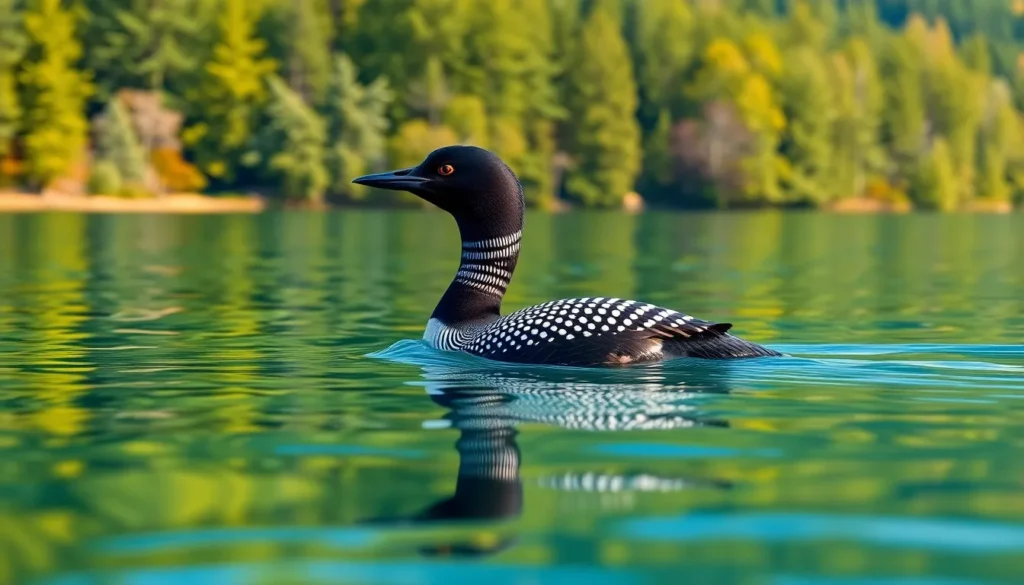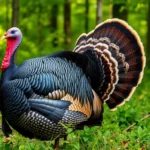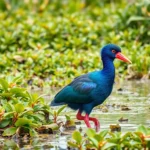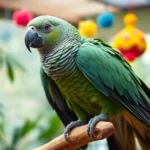We’ve all heard that haunting call echoing across a misty lake at dawn – the unmistakable voice of the loon. These magnificent waterbirds have captivated us for generations with their ethereal songs and graceful underwater ballet. From their striking black and white plumage to their remarkable diving abilities, loons represent one of nature’s most fascinating aquatic specialists.
What makes these birds so extraordinary? Loons possess incredible adaptations that allow them to thrive in aquatic environments where other birds simply can’t compete. Their solid bones help them dive to impressive depths, while their streamlined bodies cut through water like living torpedoes. Yet even though their aquatic prowess, these remarkable creatures face mounting challenges in our changing industry.
We’ll explore everything from their unique biology and mesmerizing behaviors to their cultural significance and conservation needs. Whether you’re a birdwatcher, nature enthusiast, or simply curious about these iconic lake dwellers, prepare to discover why loons hold such a special place in our hearts and ecosystems.
What Is a Loon Bird?
Loons are remarkable aquatic birds belonging to the Gaviidae family, renowned for their exceptional diving capabilities and haunting calls that echo across northern lakes. These specialized waterbirds represent one of the most ancient bird lineages on Earth.
Physical Characteristics and Size
Loons possess sturdy builds specifically adapted for aquatic life, with bodies measuring 24 to 36 inches in length depending on the species. Common loons weigh between 6 to 14 pounds, while the smaller red-throated loon weighs approximately 2 to 6 pounds. Their streamlined bodies feature solid bones rather than hollow ones like most birds, providing the density needed for efficient underwater diving.
The legs of loons are positioned far back on their bodies, creating powerful propulsion for swimming but making terrestrial movement awkward and limited. Webbed feet act as natural paddles, enabling precise underwater navigation at depths reaching 200 feet. Their pointed bills vary in size across species, with common loons displaying the most robust beaks for catching larger fish.
Wings span 40 to 58 inches across species, requiring lengthy takeoff runs of up to 100 yards across water surfaces. The wing structure prioritizes underwater flight over aerial maneuverability, with narrow profiles that slice through water during diving sequences.
Distinctive Markings and Coloration
Loon plumage displays dramatic seasonal variations, with breeding adults showcasing striking black and white patterns that create distinctive identification markers. Common loons develop intricate checkerboard patterns across their backs during summer months, complemented by solid black heads with emerald green sheens.
White striping adorns the necks of breeding adults, creating collar-like bands that vary between species. Pacific loons feature gray heads with white striping, while yellow-billed loons display ivory-colored bills contrasting against dark plumage. Red-throated loons exhibit rusty red throat patches during breeding season, creating their most recognizable field mark.
Winter plumage transforms loons into more subdued birds with gray-brown upperparts and white underparts. Juvenile loons maintain mottled brown and gray coloring throughout their first year, lacking the bold patterns of mature adults. Bill coloration shifts seasonally, with many species developing brighter hues during breeding periods before returning to darker tones in winter months.
Different Species of Loon Birds
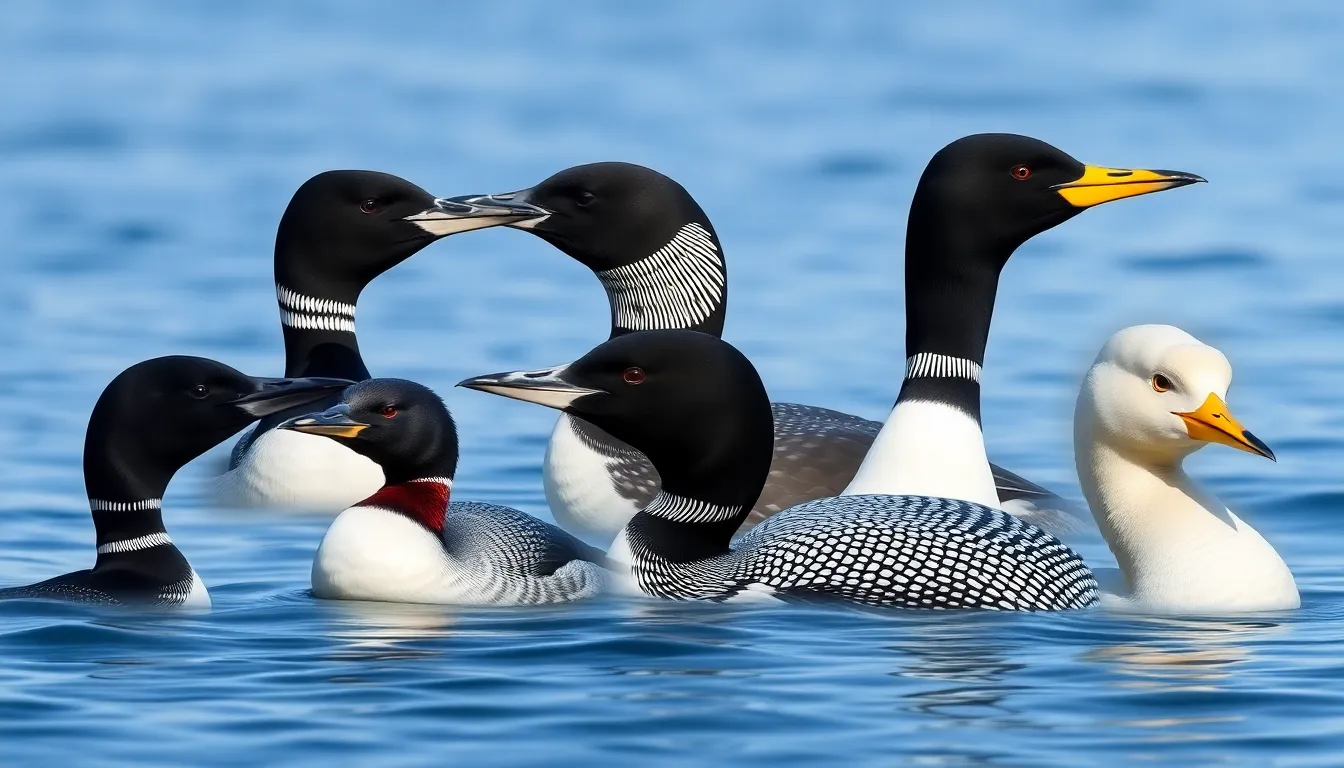
Five distinct loon species inhabit North America’s waters, each displaying unique characteristics and regional distributions. These remarkable diving birds showcase varied plumage patterns, bill structures, and behavioral adaptations across their respective habitats.
Common Loon
Common loons represent the largest and most recognizable species in the loon family, measuring 28 to 36 inches in length with weights reaching 8 to 14 pounds. Breeding adults exhibit striking black heads with distinctive white necklace markings around their necks and intricate checkerboard patterns across their backs. Their robust bills measure approximately 3 inches long and appear perfectly straight, designed for capturing fish up to 10 inches in length.
Distribution patterns show common loons breeding across Canada’s boreal forests and the northern United States, from Alaska to Maine. Winter months find these birds along both Atlantic and Pacific coastlines, extending south to the Gulf of Mexico. Population estimates indicate approximately 650,000 to 700,000 common loons exist across North America, making them the most abundant loon species.
Diving capabilities of common loons exceed those of their relatives, with recorded depths reaching 200 feet during feeding expeditions. Flight speeds average 75 mph once airborne, though takeoff requires running distances of 100 to 600 feet across water surfaces depending on wind conditions.
Red-throated Loon
Red-throated loons distinguish themselves as the smallest loon species, measuring 24 to 27 inches in length with weights ranging from 2.2 to 5.9 pounds. Breeding plumage features gray heads with distinctive rusty red throat patches that give this species its common name. Their slender, slightly upturned bills measure approximately 2 inches long and appear more delicate than those of larger loon species.
Arctic breeding grounds extend across northern Alaska, Canada, Greenland, and northern Europe, with these birds preferring smaller tundra ponds and coastal lakes. Winter distributions include temperate coastal waters along North America’s Atlantic and Pacific shores, with important populations gathering in protected bays and estuaries.
Unique adaptations allow red-throated loons to take flight directly from land, unlike other loon species requiring water takeoffs. Foraging behaviors include both freshwater and saltwater hunting, with these birds traveling up to 6 miles from nesting sites to reach productive fishing areas.
Pacific Loon
Pacific loons occupy a middle position in size among loon species, measuring 26 to 29 inches in length with weights between 3.3 and 5.5 pounds. Breeding adults display distinctive features including smooth gray heads, striped black and white neck patterns, and dark backs with white spotting arranged in neat rows. Their straight, pointed bills measure approximately 2.5 inches long and appear intermediate in robustness between common and red-throated loons.
Breeding ranges cover Alaska’s interior and western Canada’s boreal regions, with nesting occurring on medium to large freshwater lakes. Pacific populations winter primarily along the Pacific Coast from British Columbia to Baja California, though some birds migrate to Asian coastlines across the North Pacific.
Diving depths typically range from 20 to 60 feet during feeding activities, with these birds showing preferences for schooling fish such as herring and sardines. Flight patterns include direct migration routes covering distances up to 2,500 miles between breeding and wintering areas.
Yellow-billed Loon
Yellow-billed loons rank as the largest loon species globally, measuring 30 to 36 inches in length with weights reaching 8.5 to 14 pounds. Breeding adults showcase black heads with distinctive white striping patterns and bright yellow bills that measure 3.5 to 4 inches long with slightly upturned profiles. Their massive size and pale yellow bill coloration make field identification relatively straightforward compared to other loon species.
Arctic breeding distributions include northern Alaska, northwestern Canada, and northern Russia, with these birds requiring large, deep freshwater lakes for successful nesting. Winter populations concentrate along North America’s Pacific Coast and eastern Asian coastlines, though total numbers remain significantly lower than other loon species.
Population estimates suggest only 16,000 to 32,000 yellow-billed loons exist worldwide, making them the rarest North American loon species. Conservation concerns include climate change impacts on Arctic breeding habitats and potential disturbance from increased shipping activities along northern coastlines.
Loon Bird Habitat and Distribution

Loons inhabit pristine freshwater lakes across northern regions of North America, Europe, and Asia. These remarkable aquatic birds select exact water bodies that provide optimal conditions for their diving lifestyle and nesting requirements.
Preferred Water Bodies
Lakes with clear water and abundant fish populations attract loons throughout their range. Deep lakes measuring at least 20 acres offer sufficient space for takeoff runs and diving activities essential to loon survival. Rocky shorelines with secluded coves provide ideal nesting sites protected from wind and waves.
Acidic lakes with pH levels between 6.0 and 7.5 support the invertebrate populations that loons consume during breeding season. Forested shorelines create natural windbreaks and reduce human disturbance near nesting territories. Undeveloped lakes without motorboat traffic offer the quiet environment necessary for successful reproduction.
Common loons prefer larger lakes exceeding 100 acres, while red-throated loons adapt to smaller water bodies including ponds as small as 5 acres. Pacific loons select coastal lakes with direct ocean access during migration periods. Yellow-billed loons occupy the largest tundra lakes across Alaska and northern Canada.
| Loon Species | Minimum Lake Size | Preferred Depth | pH Range |
|---|---|---|---|
| Common Loon | 20+ acres | 15+ feet | 6.0-7.5 |
| Red-throated Loon | 5+ acres | 6+ feet | 5.5-7.0 |
| Pacific Loon | 10+ acres | 10+ feet | 6.0-7.5 |
| Yellow-billed Loon | 50+ acres | 20+ feet | 6.5-8.0 |
Seasonal Migration Patterns
Spring migration begins in March when ice coverage drops below 50% on northern breeding lakes. Loons travel along established flyways following major river systems and coastal routes spanning 1,000 to 3,000 miles. Adults arrive at breeding territories between April and June depending on latitude and ice conditions.
Breeding pairs establish territories covering 60 to 200 acres of lake surface during peak nesting season from May through August. Territorial boundaries extend 500 to 1,500 feet from active nests, with males defending these areas through aggressive displays and vocalizations. Family groups remain together until young loons achieve flight capability at 10 to 12 weeks of age.
Fall migration occurs from September through November as temperatures drop and food sources diminish. Adults depart breeding lakes first, followed by juvenile loons approximately 2 weeks later. Winter habitats include coastal waters, large unfrozen lakes, and southern reservoirs from October through March.
Pacific coast populations migrate to marine environments along California, Oregon, and Washington shorelines. Atlantic coast loons overwinter from Nova Scotia south to Florida’s Gulf Coast. Interior populations use the Great Lakes, major river systems, and ice-free reservoirs throughout the southern United States.
Behavior and Lifestyle of Loon Birds
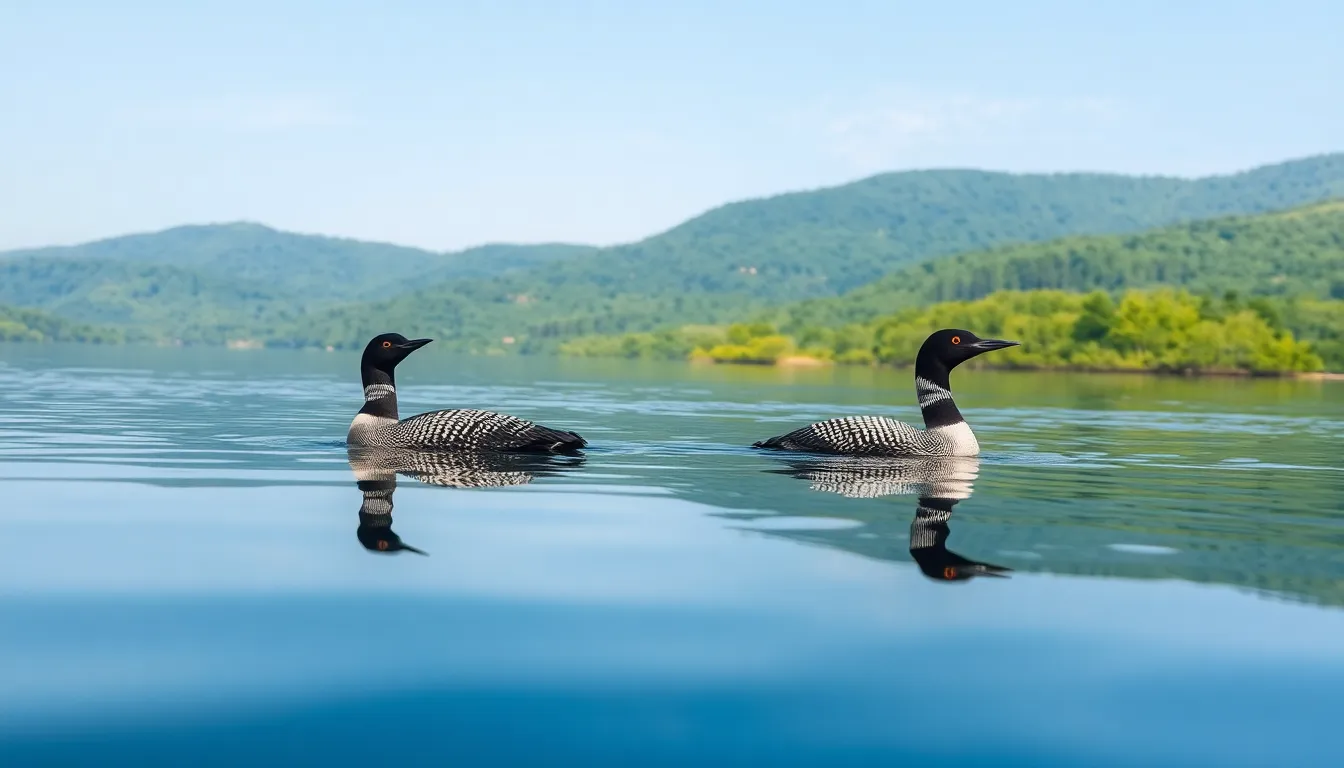
Loons exhibit complex behaviors that reflect their specialized aquatic lifestyle and ancient evolutionary heritage. These remarkable birds demonstrate sophisticated hunting strategies and maintain intricate social systems throughout their lives.
Diving and Hunting Techniques
Loons showcase extraordinary underwater hunting abilities that surpass most other waterfowl species. We observe these birds plunging to depths exceeding 200 feet while pursuing fish beneath lake surfaces. Their hunting technique involves systematic scanning from the surface before executing precise dives that last 1 to 3 minutes.
Underwater propulsion occurs through powerful leg strokes while their wings remain tightly folded against their bodies. Loons can swim at speeds reaching 5 miles per hour beneath the surface when chasing prey. Their hunting success depends on their ability to adjust buoyancy by compressing air from their feathers and lungs before diving.
Fish comprise 90% of their diet, with preferred species including perch, pike, bass, and trout ranging from 4 to 12 inches in length. Loons also consume aquatic invertebrates, crustaceans, and amphibians when fish populations decline. Their pointed bills function like spears, allowing them to grasp slippery prey with backward-facing projections along their tongue and palate.
Cooperative hunting occurs occasionally when multiple loons work together to corner schooling fish in shallow areas. Parents demonstrate hunting techniques to their young by bringing captured fish to the surface and releasing them for practice catches.
Territorial Nature and Social Structure
Loons maintain strict territorial boundaries during breeding season, with established pairs defending areas ranging from 60 to 200 acres of lake surface. Males arrive at breeding territories 1 to 2 weeks before females and begin aggressive displays to secure prime nesting locations. Territory size correlates directly with fish abundance and suitable nesting sites along shorelines.
Territorial disputes involve elaborate posturing displays including the “penguin dance” where loons rear up vertically while flapping their wings. Vocal confrontations accompany these displays, with tremolo calls signaling agitation and wails establishing territorial claims across distances up to 2 miles.
Pair bonds form through synchronized swimming patterns and duet calling between mates. Established pairs often return to the same territory for multiple breeding seasons, though site fidelity depends on habitat quality and previous nesting success. Divorce rates among loons reach 30% annually, typically occurring after failed breeding attempts.
Family groups consist of both parents and 1 to 2 chicks during the 10 to 12 week fledgling period. Parents share responsibilities equally, with one adult foraging while the other guards young from predators and territorial intruders. Chick transportation occurs on parents’ backs during the first 8 weeks, providing protection from cold water and aquatic predators.
Winter social structures differ dramatically as loons become largely solitary on coastal waters and inland lakes. Loose aggregations form in areas with abundant food sources, but competitive interactions remain minimal during non-breeding seasons.
The Iconic Loon Bird Call
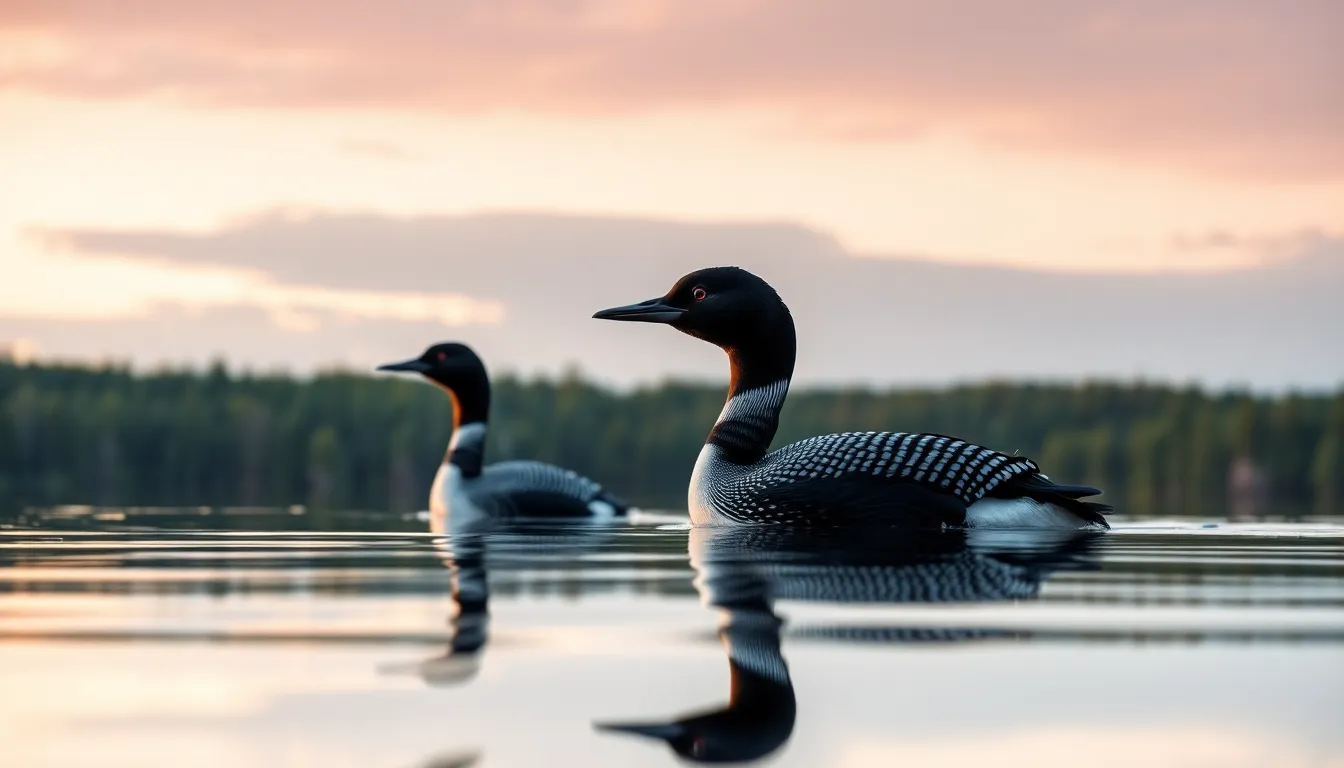
The haunting wail of loons creates one of nature’s most recognizable and emotionally stirring sounds. These vocalizations carry across northern lakes for distances up to 3 miles, establishing their presence in wilderness landscapes.
Types of Vocalizations
Loons produce four distinct vocal categories, each serving exact behavioral purposes. The wail represents their most famous call, lasting 1 to 3 seconds with a mournful quality that rises and falls in pitch. Adult loons use wails for long distance communication between family members and territorial announcements.
Tremolo calls consist of rapid, laughing notes that signal alarm or agitation. These calls range from 0.5 to 2 seconds in duration and increase in intensity when threats approach nesting areas. Loons emit tremolos while flying, earning them the nickname “crazy loon” from early settlers.
Yodel calls come exclusively from male loons defending their territories. Each male produces a unique yodel pattern lasting 2 to 4 seconds, serving as an acoustic fingerprint that identifies individuals. The pitch varies dramatically within each yodel, creating complex harmonic structures that carry across water surfaces.
Hoot calls represent the softest loon vocalization, used for close range family communication. Parents exchange quiet hoots with their chicks during feeding and navigation activities. These intimate sounds rarely travel beyond 100 yards from their source.
Communication and Mating Calls
Breeding pairs develop synchronized calling patterns that strengthen their pair bonds throughout the nesting season. Males initiate duet sequences with territorial yodels, prompting females to respond with complementary wails that create harmonic partnerships. These vocal exchanges occur most frequently during dawn and dusk hours when sound travels farthest across calm water.
Courtship calling intensifies during pre-breeding displays in May and June. Paired loons perform synchronized swimming while exchanging soft hoots and gentle wails, reinforcing their commitment to shared territorial defense. The frequency and duration of these intimate calls correlates directly with successful breeding outcomes.
Chick communication begins before hatching, with embryos producing peeping sounds from inside their eggs. Adult loons respond to these pre-hatching calls with low hoots, establishing vocal recognition patterns. Young loons develop their full vocal repertoire over 12 to 15 weeks, practicing each call type under parental guidance.
Seasonal variations affect loon vocalizations significantly, with peak calling activity occurring during breeding months. Winter loons rarely vocalize except for brief contact calls between feeding partners. The return of spring calling marks territorial establishment and the beginning of another breeding cycle.
Breeding and Nesting Habits
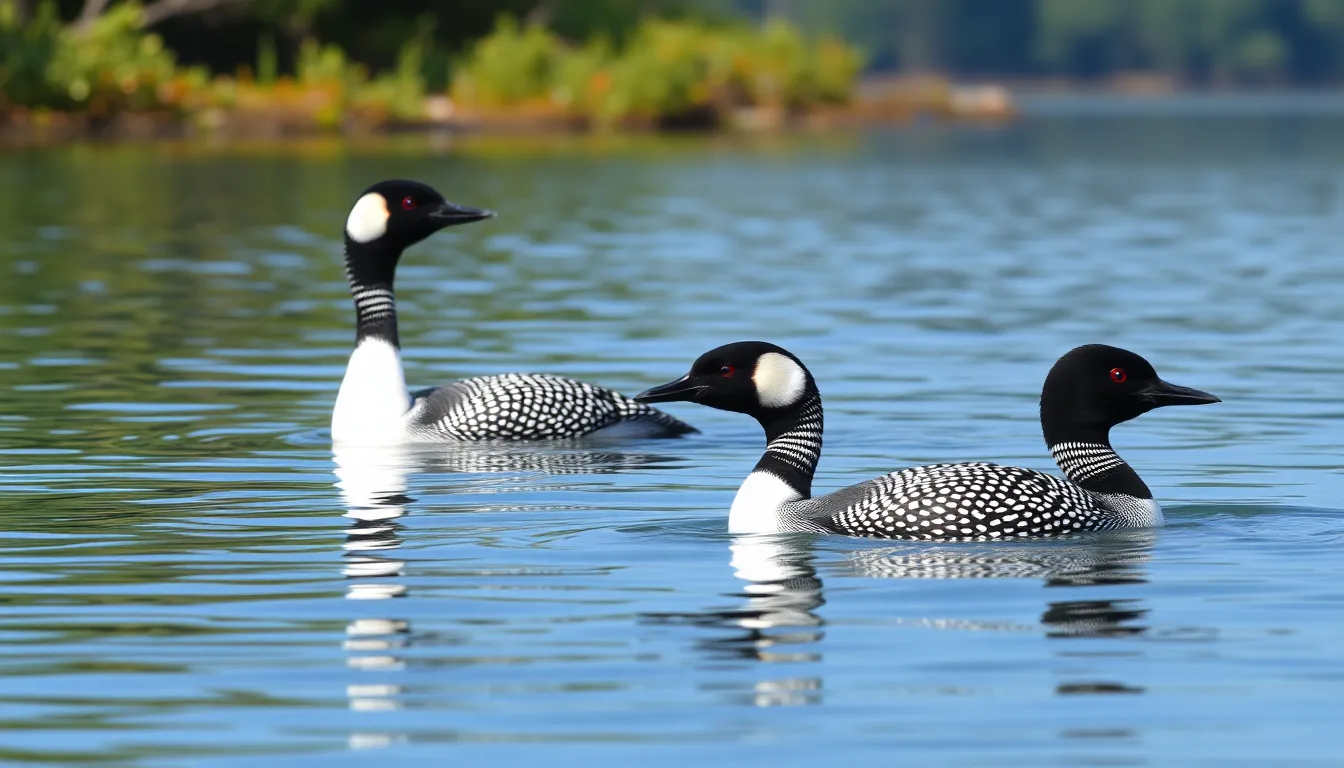
Loons exhibit fascinating breeding behaviors that reflect their ancient evolutionary heritage and specialized aquatic lifestyle. These remarkable birds engage in elaborate courtship displays and demonstrate exceptional parental dedication during their reproductive season.
Mating Rituals and Pair Bonding
Loon pairs reunite at their breeding territories each spring using sophisticated courtship displays that strengthen their lifelong bonds. Males perform the “penguin dance” by rearing upright on the water’s surface with wings spread wide and heads thrust forward in a dramatic territorial announcement. Synchronized swimming creates mesmerizing patterns as pairs glide side by side across pristine lake surfaces while maintaining perfect coordination.
Courtship feeding rituals involve males presenting fish offerings to females as demonstrations of their hunting prowess and territory quality. Pairs engage in mutual preening sessions that reinforce their partnership bonds through gentle bill touches and feather arrangement activities. Duet calling reaches its peak intensity during courtship periods with males producing deep yodel calls while females respond with complementary wail vocalizations.
Bill dipping ceremonies mark important bonding moments as pairs simultaneously lower their heads underwater in graceful unison movements. Dancing displays feature rapid wing beating while birds remain stationary on water surfaces creating impressive spray patterns around their bodies. Mated pairs typically return to the same territories year after year with site fidelity rates exceeding 80% among established breeding couples.
Nest Construction and Egg Care
Loons construct their nests directly on shoreline vegetation within 3 feet of water’s edge to enable quick escape routes during predator encounters. Both parents gather aquatic plants including sedges and cattails to build circular platforms measuring 18 to 24 inches in diameter. Nest sites feature shallow depressions lined with softer materials such as moss and grass blades for optimal egg insulation.
Females typically lay 1 to 2 olive brown eggs with dark spots between late May and early July depending on geographic location and seasonal conditions. Incubation duties alternate between both parents over 26 to 31 day periods with adults maintaining constant egg temperatures through specialized brood patches. Parents rotate incubation shifts every 4 to 6 hours while the off duty bird feeds extensively to maintain energy reserves.
Egg turning occurs approximately every 2 hours to ensure proper embryonic development and prevent membrane adhesion problems. Nest maintenance continues throughout incubation as parents add fresh vegetation and adjust platform height in response to changing water levels. Protective behaviors intensify during the final week before hatching with parents rarely leaving eggs unattended for more than 15 minute intervals.
Diet and Feeding Patterns
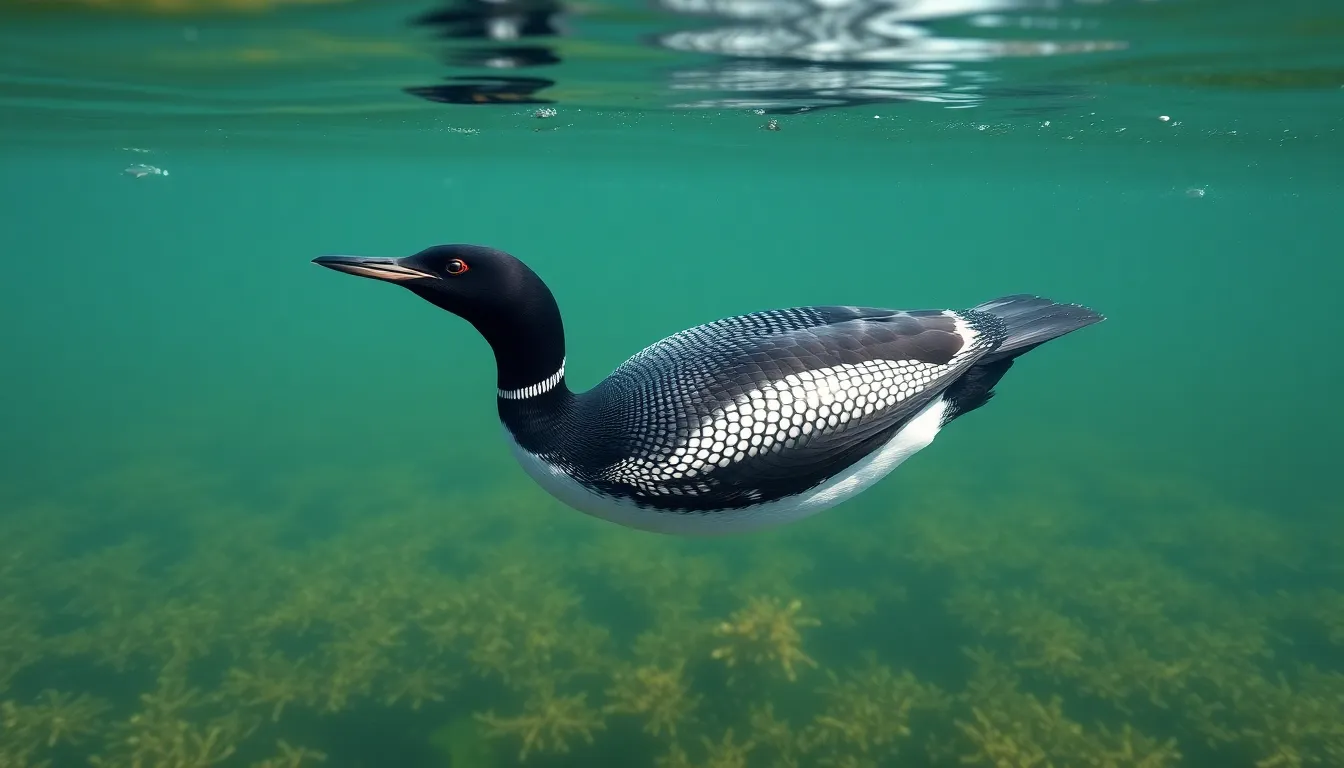
Fish comprise 90% of the loon’s diet, with yellow perch, northern pike, suckers, and trout representing their primary prey species. We observe these aquatic hunters targeting fish ranging from 4 to 12 inches in length, though they can capture prey up to 18 inches when necessary.
Primary Food Sources
Common loons consume approximately 2 pounds of fish daily during peak feeding periods. Their diet varies seasonally and includes:
| Prey Type | Percentage of Diet | Size Range |
|---|---|---|
| Yellow Perch | 35% | 6-10 inches |
| Northern Pike | 20% | 8-14 inches |
| Suckers | 15% | 4-8 inches |
| Trout Species | 12% | 6-12 inches |
| Other Fish | 8% | 3-15 inches |
| Crustaceans | 7% | 1-3 inches |
| Aquatic Insects | 3% | 0.5-2 inches |
Crustaceans like crayfish and freshwater shrimp supplement their fish based diet, particularly during molting periods when loons cannot fly. Aquatic insects including dragonfly larvae, water beetles, and mayflies provide essential nutrients for developing chicks.
Hunting Techniques and Feeding Behavior
Diving hunting represents the loon’s most effective feeding strategy, with successful capture rates reaching 75% in optimal conditions. These birds scan underwater environments systematically, rotating their heads 180 degrees to locate prey before initiating pursuit dives.
Pursuit diving involves high speed underwater chases where loons reach swimming speeds of 8 miles per hour. Their solid bones provide negative buoyancy, allowing effortless submersion to depths exceeding 200 feet. Hunting dives typically last 42 seconds, though emergency dives can extend to 3 minutes when evading predators.
Surface feeding occurs less frequently but proves effective for capturing small fish in shallow waters. Loons employ this technique primarily during early morning and late evening hours when fish move closer to the surface.
Feeding Patterns Throughout Life Stages
Adult feeding patterns demonstrate remarkable consistency across breeding territories, with pairs consuming 4 to 6 pounds of fish combined daily. Males often hunt in deeper waters while females focus on nearshore areas, reducing competition for food resources within their territory.
Chick feeding requirements intensify parental hunting efforts significantly during the first 8 weeks after hatching. Parents deliver whole fish to their young every 30 to 45 minutes throughout daylight hours. Young loons receive progressively larger prey as they mature, starting with 2 inch minnows and graduating to 6 inch fish by fledging.
Seasonal feeding adjustments reflect prey availability and metabolic demands. During migration periods, loons increase their daily fish consumption by 40% to build fat reserves for long distance flights. Winter feeding occurs in marine environments where they target saltwater species including herring, sardines, and small cod.
Digestive Adaptations for Fish Consumption
Specialized digestive systems enable loons to process their fish heavy diet efficiently. Their bills feature backward pointing projections called papillae that prevent slippery prey from escaping during swallowing. Powerful stomach acids break down bones and scales completely within 6 to 8 hours.
Gizzard stones aid in grinding fish bones and hard crustacean shells. Loons deliberately ingest small pebbles from lake bottoms, storing 15 to 20 stones weighing up to 45 grams total in their muscular gizzards. These gastroliths remain functional for several months before being replaced through natural regurgitation and new stone consumption.
Conservation Status and Threats
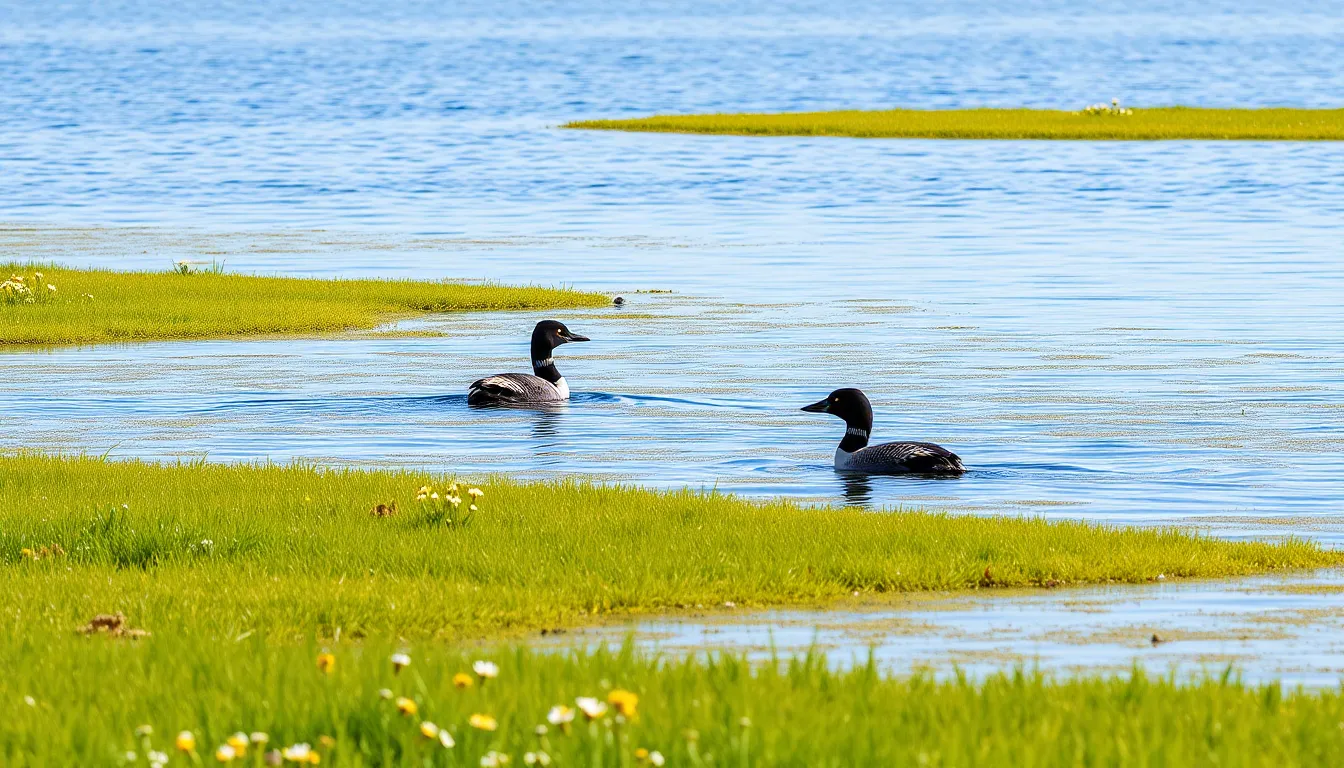
Loon bird populations face mounting pressures from environmental degradation and human activities across their range. These ancient diving birds encounter multiple threats that challenge their survival and reproductive success.
Environmental Challenges
Climate change significantly impacts loon bird breeding cycles and habitat availability. Rising temperatures alter lake chemistry and reduce ice cover duration, affecting the timing of spring migration and nesting activities. Scientists documented temperature increases of 2.3°F across northern breeding regions over the past 30 years, disrupting traditional breeding schedules.
Habitat loss accelerates as shoreline development fragments pristine lake environments essential for loon bird populations. Residential construction eliminates 40% of suitable nesting sites along heavily developed lakes compared to undisturbed waters. Motorboat traffic creates wake action that floods low nests and disturbs feeding areas during critical breeding periods.
Water pollution poses serious threats through mercury contamination and acid rain effects. Mercury levels in adult loon birds measure 3 to 5 times higher than safe thresholds in industrialized regions. Acidic waters reduce fish populations and calcium availability, leading to thinner eggshells and decreased reproductive success rates.
Lead poisoning from fishing tackle kills approximately 25% of adult loon birds in some regions annually. Discarded lead sinkers and jigs contaminate water bodies where loon birds hunt and accidentally ingest toxic materials while pursuing fish.
Protection Efforts
Conservation organizations carry out comprehensive monitoring programs across North America to track loon bird population trends. The Loon Preservation Committee operates 200 active monitoring sites, documenting breeding success rates and identifying critical habitat areas requiring protection.
Artificial nesting platforms provide secure breeding sites where natural shoreline habitat faces disturbance. Wildlife managers install floating platforms that rise and fall with water levels, increasing nesting success rates by 60% in participating lake systems. Volunteers maintain these structures and monitor reproductive outcomes throughout breeding seasons.
Legislative measures protect critical loon bird habitat through designated wildlife refuges and seasonal restrictions. Canada establishes 15 new protected areas totaling 2.3 million acres specifically for loon bird conservation. State wildlife agencies enforce boating speed limits during nesting seasons and restrict shoreline development within 200 feet of documented nesting sites.
Public education campaigns reduce lead tackle use and promote loon bird friendly practices among recreational users. Tackle exchange programs remove 8,000 pounds of lead fishing gear annually while providing anglers with non-toxic alternatives. Educational materials reach 50,000 lake property owners through workshops and conservation guides focused on protecting loon bird habitat.
Best Places to Observe Loon Birds
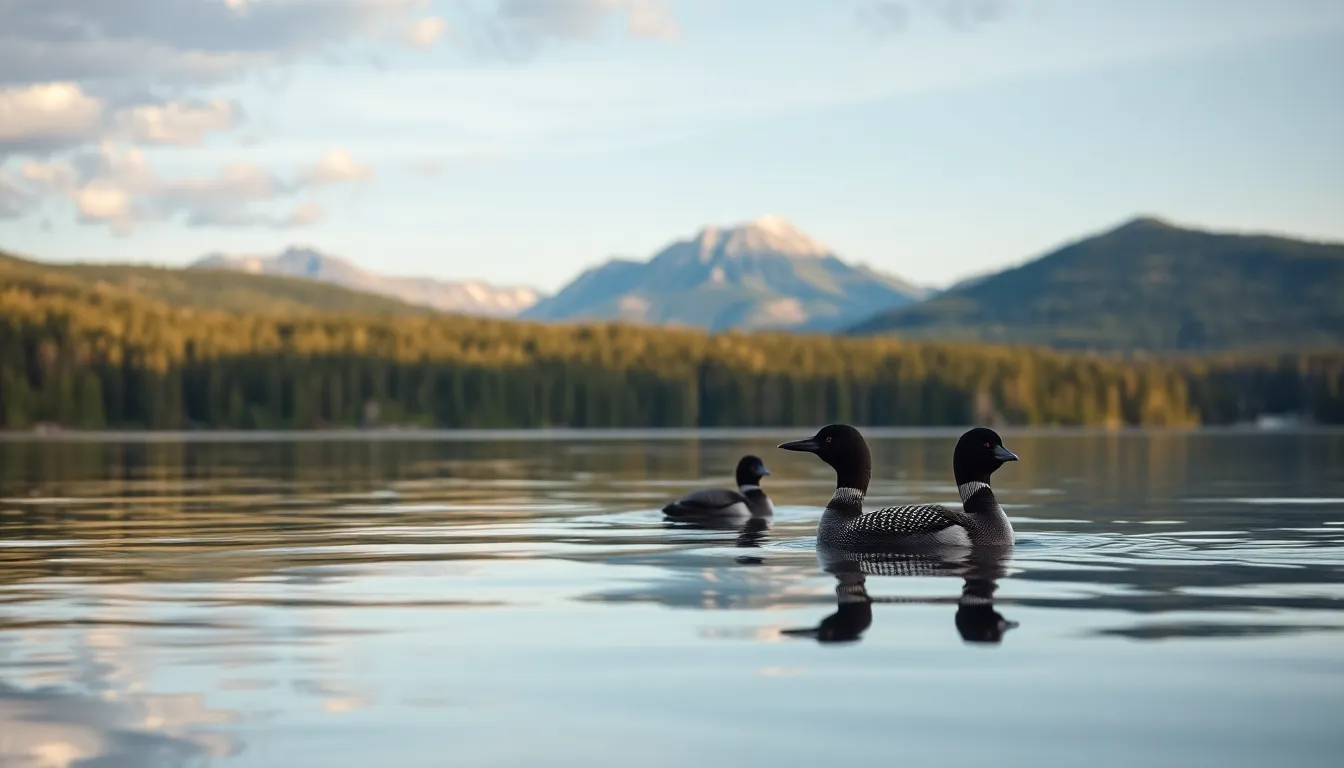
Prime loon viewing opportunities exist across North America’s pristine lake systems during exact seasonal windows. We identify optimal observation sites based on breeding populations, accessibility, and seasonal migration patterns that maximize wildlife viewing experiences.
Northern Wilderness Lakes
Boundary Waters Canoe Area Wilderness in Minnesota hosts the largest concentration of Common Loons in the contiguous United States. Over 10,000 loons inhabit these interconnected waterways during breeding season from May through August. Seagull Lake and Saganaga Lake provide exceptional viewing opportunities with established loon territories spanning 60 to 200 acres each.
Algonquin Provincial Park in Ontario contains approximately 3,000 loons across 2,400 lakes during peak breeding months. Lake of Two Rivers and Canoe Lake offer roadside access points where observers frequently spot loon families teaching diving techniques to their young. Early morning hours between 6:00 AM and 9:00 AM produce the highest activity levels for feeding and territorial displays.
Adirondack Park in New York supports nearly 2,000 breeding pairs across 3,000 lakes and ponds. Saranac Lake and Lake Placid feature public boat launches and shoreline viewing areas where loons demonstrate their synchronized swimming behaviors during courtship season from April through June.
Coastal Migration Corridors
Great Lakes shorelines serve as critical stopover points during fall migration from September through November. Lake Superior’s north shore between Duluth, Minnesota and Thunder Bay, Ontario attracts thousands of migrating loons seeking abundant fish populations before continuing to oceanic wintering grounds.
Pacific Coast observations peak during winter months from December through February when loons concentrate in protected bays and estuaries. Puget Sound in Washington State hosts an estimated 15,000 to 20,000 loons annually, with prime viewing locations at Discovery Park in Seattle and Deception Pass State Park.
Atlantic Coast migration routes feature consistent loon populations along Maine’s rocky shoreline during October and November. Acadia National Park’s Jordan Pond and Eagle Lake provide freshwater viewing opportunities, while Bar Harbor’s coastal areas offer chances to observe Red-throated Loons in their winter plumage.
Specialized Viewing Locations
Yellowstone National Park’s high-elevation lakes support unique breeding populations of Common Loons at altitudes exceeding 7,000 feet. Yellowstone Lake hosts 20 to 30 breeding pairs that demonstrate remarkable adaptation to harsh mountain conditions and shorter breeding seasons lasting from June through August.
Alaska’s wilderness areas contain the highest density of all five loon species in North America. Denali National Park’s Wonder Lake provides opportunities to observe Yellow-billed Loons, the rarest North American species with fewer than 10,000 individuals globally. Arctic National Wildlife Refuge supports important populations of Pacific Loons and Red-throated Loons during their abbreviated breeding season from May through July.
Canadian Shield lakes across Ontario, Quebec, and Manitoba offer consistent loon viewing throughout the breeding season. Lake Winnipeg and surrounding water bodies host thousands of loons during migration periods, creating spectacular concentrations visible from multiple shoreline access points and provincial parks.
Conclusion
Loons stand as remarkable testaments to nature’s evolutionary brilliance combining ancient lineage with perfectly adapted aquatic mastery. These magnificent birds continue to captivate us with their haunting calls and extraordinary diving abilities while facing unprecedented conservation challenges.
We’ve witnessed how loons balance their roles as skilled hunters territorial defenders and devoted parents across the pristine waters of North America. Their complex behaviors and seasonal adaptations showcase nature’s intricate design at its finest.
As stewards of these northern waterways we must protect the habitats that sustain loon populations for future generations. Every conservation effort from reducing lead tackle to preserving nesting sites contributes to ensuring these iconic birds continue gracing our lakes with their presence.
The next time you hear a loon’s call echoing across still waters remember you’re experiencing one of nature’s most ancient and powerful connections between wilderness and wonder.
Frequently Asked Questions
What makes loons such exceptional divers?
Loons possess unique adaptations for underwater hunting, including solid bones that help them sink, streamlined bodies for efficient movement, and legs positioned far back for powerful propulsion. They can dive to depths exceeding 200 feet and hold their breath for several minutes while hunting fish, which comprises 90% of their diet.
How many species of loons are found in North America?
Five distinct loon species inhabit North American waters: Common Loon (largest), Red-throated Loon (smallest), Pacific Loon, Yellow-billed Loon (globally largest but rarest in North America), and Arctic Loon. Each species has unique characteristics, size ranges, and regional distributions across northern lakes and coastal areas.
What do loon calls mean and how far can they travel?
Loons produce four main call types: wails for long-distance communication, tremolos for alarm, yodels for territorial defense, and hoots for close-range family communication. These haunting calls can carry across northern lakes for distances up to 3 miles, with breeding pairs developing synchronized calling patterns to strengthen their bonds.
Where is the best place to see loons in the wild?
Prime loon viewing locations include Boundary Waters Canoe Area Wilderness in Minnesota, Algonquin Provincial Park in Ontario, and Adirondack Park in New York. The best viewing times are during breeding season (May-September) on clear, deep northern lakes, and during migration along the Great Lakes and coastal areas.
What are the main threats to loon populations?
Loons face multiple threats including climate change affecting their habitat, shoreline development destroying nesting sites, water pollution impacting fish populations, and lead poisoning from fishing tackle. Human disturbance during breeding season and habitat degradation also significantly impact their reproductive success and population stability.
How do loons build their nests and raise their young?
Loons construct circular nests on shoreline vegetation near water’s edge, with both parents sharing building duties. They typically lay 1-2 olive brown eggs, sharing incubation responsibilities for about 28 days. Parents demonstrate exceptional dedication, teaching chicks hunting techniques and protecting them until they can fly independently.
Why are loons considered one of the most ancient bird lineages?
Loons represent one of Earth’s most ancient bird lineages, with fossil evidence showing minimal evolutionary changes over millions of years. Their primitive characteristics and specialized aquatic adaptations have remained largely unchanged, making them living representatives of prehistoric avian evolution and earning them recognition as “living fossils.”

